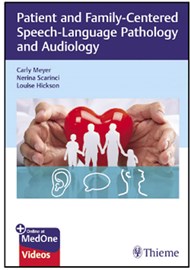This book highlights the importance of giving patient and family-centred care (PFCC) in clinic to those with a communication difference. Input is included from informed healthcare professionals, and its focus is on the ‘how to’ with evidenced-based methods for improving patient outcomes.
With learning objectives introducing each chapter and end-of-chapter summaries with tips and reflection questions, this book will appeal primarily to students so that they are encouraged to develop a PFCC mindset during their training and beyond. Inclusion of diagrams, graphs, online links and 29 video examples involving patients, families and clinicians caters to all learning styles making it user friendly. However, its ease of reference makes it a useful addition to a clinician’s bookshelf too. It would serve to refresh knowledge and to touch upon concepts that may not have been considered in day-to-day roles or, otherwise, endorse what is already being done.
The importance of taking account of the wide-ranging impacts of communication difficulties on a patient and family is conveyed by realistic clinical examples in the first chapter. The book acknowledges that a PFCC approach may be difficult to maintain amidst daily tasks. However, it reassures the reader of their valid concerns and suggests solutions. The emphasis is on the need for reflective practice, and tools such as Gibbs’ Reflective Cycle are provided.
Of particular interest to those, probably most of us, who practise in ethnically diverse areas is the final chapter on how to be effectively responsive to culturally and linguistically diverse (CALD) families in the planning and delivery of our services. Cultural differences are explored with examples from Singaporean, Iranian and Aboriginal communities, as well as LGBT+ communities. These communities must feel they can attend with understanding and without a fear of stigma for improved outcomes.The book details the positive impact of PFCC outcomes on patients, families, clinicians and at service level, making it relevant for all levels of expertise to improve their service.
The book can also be applied across healthcare disciplines, and accounts are provided from occupational therapists, a psychologist as well as audiologists and speech and language pathologists which adds a direct, personal touch, including why an audiologist went into the profession.
This book comes recommended as a guide on how to interact with patients and families to improve “treatment satisfaction and measureable success”.




